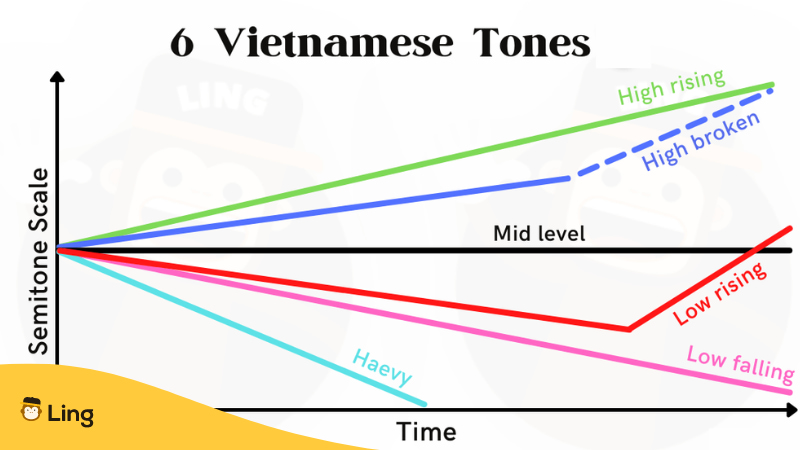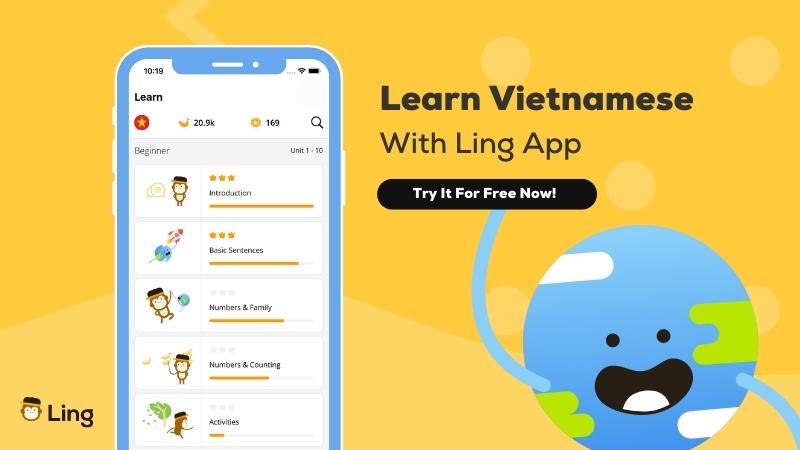If you’re traveling khổng lồ Vietnam, a handy danh mục of Vietnamese words and phrases is the best thing you can “pack” in your luggage. If nothing else, knowing a few words in Vietnamese helps you connect with the place a bit more. Besides, the smiles you’ll get from the locals are worth the effort of building a basic vocabulary.
Bạn đang xem: Top 10 hardest vietnamese words to pronounce
Now it all comes down to the words you’re going lớn learn. Putting up the work to lớn learn is commendable, but not all Vietnamese words are equally important for a traveler. If you want to lớn make the most of what you’re learning, it’s important khổng lồ focus on basic, high-frequency words that are more likely to lớn pop up in small talk & daily conversations. So here’s a menu of vi xử lý core Vietnamese words and phrases any traveler should know.
The most common Vietnamese words
Studies have shown that knowing as little as 100 words in Vietnamese will help you comprehend 1/2 of any communication in Vietnamese. This is why we are going khổng lồ focus on the most common Vietnamese words first. These everyday words are the ones you’ll probably use the most in your daily conversations while in Vietnam.
easy — dễhard — cứnggood — tốtbad — tồi tệnear — gầnyes — vângno — không(to) have — có(I) use — (tôi) dùng(to) go — đi(to) come — đến(to) laugh — cười cợt to(to) make — làm(I) lượt thích — (tôi) thích(to) want — muốn(to) take — cầm(to) see — quan sát thấyfar — xasmall — nhỏbig — tobeautiful — đẹpugly — xấuweek — tuầnyear — nămtoday — hôm naytomorrow — ngày maiyesterday — hôm quahour — giờminute — phúttime — thời gianMonday — máy hai
Tuesday — sản phẩm ba
Wednesday — lắp thêm tư
Thursday — sản phẩm năm
Friday — vật dụng sáu
Saturday — đồ vật bẩy
Sunday — công ty nhậtone — mộttwo — haithree — bafour — bốnfive — nămsix — sáuseven — bảyeight — támnine — chínten — mườiwhat — chiếc gìwhere — làm việc đâuwho — ai

The most common Vietnamese phrases and greetings
Greetings and other common phrases are just as important for your Vietnamese adventure. Using the right courtesy phrases và greetings leads to more fun interactions and helps khổng lồ break the cultural ice. Besides, simple Vietnamese phrases lượt thích ‘good morning’, ‘how are you’ or ‘you’re welcome’ are the most efficient way khổng lồ look confident & feel lượt thích you could carry an entire conversation in Vietnamese any day now.
Good morning! — xin chào chị!Good afternoon! — xin chào buổi chiều!Good evening! — chào buổi tối!Good night! — Chúc ngủ ngon!Hello! — Xin chào!How are you? — khỏe khoắn không?Very good, thank you. — Được rồi, cảm ơn cô.What is your name? — Tên bạn là gì?
My name is_____ — tên tôi là _____.Nice to lớn meet you. — rất vui được gặp gỡ bạn.Please. — làm ơn.Thank you. — Cảm ơn.Thank you very much. — Cảm ơn vô cùng nhiều.Great. — giỏi quá.I’m sorry. — Tôi xin lỗi.You’re welcome. — không có gì.Excuse me. — Xin lỗi mang lại tôi hỏi.No problem. — Không sự việc gì.Speak slowly. — Nói chậm chạp thôi.Where are you from? — các bạn từ đâu đến?
What time is it? — Mấy giờ đồng hồ rồi?
Can you help me? — chúng ta có thể giúp tôi chứ?
How much does it cost? — giá bán bao nhiêu?
Goodbye! — Hẹn gặp lại nhé!
Being a tonal language makes Vietnamese hard khổng lồ pronounce for some of us. If you need help with this, here’s a short đoạn phim to help you learn how to lớn pronounce some of the above-mentioned phrases:
However, if you want more, you can always tải về the Mondly phầm mềm to learn Vietnamese pronunciation directly from native speakers.
Vietnamese words và phrases related to lớn food và drink
Whether you’re a foodie or not, adding a bit of “flavor” to lớn your Vietnamese vocabulary will surely come in handy if you’re eating out. After all, food is an essential part of any trip. You don’t just visit a new country; you also taste it. Wouldn’t you agree?
water — nướctea — tràcoffee — cà phêjuice — nước épwine — rượubeer — biaalcohol — rượuchicken — món gà ạfish — cásoup — xúpsalad — món rau trộnsandwich — bánh mỳ kẹppie — bánh nướng nhân ngọtbread — bánh mìdessert — món tráng miệngcake — bánh ngọtbreakfast — bữa sánglunch — bữa trưadinner — bữa tốisalt — muốisugar — đườngpepper — hạt tiêuno sugar — không đườngI have a reservation. My name is _____. — Tôi gồm đặt trước. Thương hiệu tôi là_____.What would you recommend? — chúng ta cũng có thể giới thiệu mang lại tôi món gì?
I’d like something without meat. — Tôi mong muốn một cái gì đó với thịt.
Vietnamese words related to toàn thân and health
The names of the body toàn thân parts in Vietnamese are some of the most common và useful words you can learn. Whether you are at the doctor’s office, in a clothing store or training for a scuba diving session, various parts of the body toàn thân can pop up in conversation more often than you’d imagine.
head — đầuhair — tócneck — cổchest — ngựcarm — cánh tayfinger — ngón tayfoot — bàn chânface — khuôn mặteye — mắthand — bàn taynose — mũimouth — miệngleg — chânknee — đầu gốidisease — bệnhallergy — dị ứngfever — sốtpain — đaumedicine — y khoapharmacy — dượcI feel sick. — Tôi cảm giác say.Can you help me? — chúng ta có thể giúp tôi chứ?
Where is the hospital? — bệnh viện ở đâu?
Please gọi a doctor. — Xin gọi bác sỹ.

Vietnamese words related to lớn transportation và places
Do you need to go somewhere? It’s best if you know the Vietnamese words for means of transportation and places you may want lớn go to. This way, you’ll be able lớn prevent difficult situations where locals cannot understand what you are trying lớn say.
airplane — thứ baytrain — tàu hỏataxi — tắc xicar — ô tôbus — xe buýtticket — vérestaurant — đơn vị hànghotel — khách sạnairport — sảnh baytrain station — đơn vị gamarket — chợUseful Vietnamese phrases for khách sạn stays
If you need a place to crash, this crash course in Vietnamese phrases for common conversations in relation to hotel stays will come in handy. Learn these phrases today và make Vietnamese-speaking friends tomorrow!
I have booked a room. — Tôi đang đặt trước một phòng.The key for room _____, please. — cho tôi chiếc chìa khóa phòng _____.This room is too noisy. — chống này ồn quá.When is check-out time? — giờ trả phòng là mấy giờ?Thank you for your help. — Cảm ơn sự hỗ trợ của bạn.How was your stay with us? — Anh cảm thấy ở khách hàng sạn shop chúng tôi thế nào?
Here is your bill, please look it over. — Hóa đối kháng của anh đây, phiền anh xem lại.
That’s it! You are now officially ready lớn embark on an unforgettable trip to Vietnam. Don’t forget that practice makes perfect.
From 0 lớn conversational in Vietnamese
Do you want to lớn go beyond basics and speak Vietnamese fluently? Try Mondly, the award-winning language app that is serious about making learning Vietnamese fun.
Instead of tiring yourself for hours with inch-thick textbooks, slip a 10-minute Mondly lesson into your routine và make learning a breeze. You will learn Vietnamese naturally using:
practical topics;hands-on, interactive language lessons;intelligent suggestions and instant feedback on pronunciation;crystal-clear audios of native speakers;real-life conversations and so much more.Start using Mondly for không tính tiền on your computer or download the app và learn Vietnamese anytime, anywhere.
Vietnamese is a tonal language. It means that you need lớn learn how khổng lồ pronounce Vietnamese tones correctly as the tones play an important role in the meaning of a Vietnamese word or phrase. There are six (6) tones in the Vietnamese language with five (5) tone marks that we will have you covered today:
Mid-Level Tone (Thanh Ngang): doesn’t have a tone markLow Falling Tone (Thanh Huyền): the tone mark for the low falling tone is ” ” (dấu huyền)High Rising Tone (Thanh Sắc): the tone mark for this tone is “/” (dấu sắc)Low Rising Tone (Thanh Hỏi): the low rising tone has the tone mark looks like a question mark without a dot called “dấu hỏi”High Broken Tone (Thanh Ngã): the tone mark for the high broken tone is “~”Heavy Tone (Thanh Nặng): the heavy tone has the tone mark as a dot “.” we add it under the vowelsWhat Are The Six Vietnamese Tones?
Different tonal languages have different numbers of tones. For example, thai has five toneswhile Cantonese has nine tones. There are six tones in Vietnamese that you need khổng lồ learn và master when you learn Vietnamese.

1. Mid-Level Tone (Thanh Ngang)
The mid-level tone in Vietnamese is called “thanh ngang”. To lớn pronounce the mid-level tone, keep your voice flat and even. Don’t raise your voice nor make it fall. “Thanh Ngang” will sound similar lớn “sing” in an affirmative sentence in English.
The mid-level tone doesn’t have a tone mark.
Below are some words that have the mid-level tone or flat tone:
Ca – to sing
PlayMa – a ghost
PlayBa – dad, three
PlayLa – lớn scream out loud, khổng lồ shout out loud
PlayHoa – a flower
Play2. Low Falling Tone (Thanh Huyền)
The low falling tone or “thanh huyền” is pronounced when you low down your voice. It sounds similar to “Uhm” in English when you agree with someone about something.
The tone mark for the low falling tone is ” ” (dấu huyền) which looks like it is in the word “huyền” or in the following examples:
Cà – eggplant
PlayMà – that, which
PlayBà – grandma
PlayLà – khổng lồ be
PlayHoà – even, lớn mix
Play3. High Rising Tone (Thanh Sắc)
Thanh nhan sắc is the Vietnamese name of the high rising tone in Vietnamese. You need to raise your voice up quickly to lớn create this tone. It sounds similar lớn “What???” in English.
The tone mark for this tone is “/” (dấu sắc) as you can see in the word “sắc”. Many words have this tone mark, as follows:
Cá – a fish
PlayMá – cheek, mom (in Southern Vietnamese dialect)
PlayBá – mother’s older sister (in Northern Vietnamese accent)
PlayLá – a leaf
PlayHoá – chemistry
Play4. Low Rising Tone (Thanh Hỏi)
“Thanh Hỏi” or “Low Rising Tone” is created when you first low down your voice as in “thanh huyền”, then raise up your voice at the over of the word. It will sound similar to lớn “really?” but a bit faster.
The low rising tone has the tone mark called “dấu hỏi” and the tone mark looks lượt thích a question mark without a dot and is put on the đứng đầu of a word lượt thích it is in the word “hỏi.”
Below are more examples of the Vietnamese words with “dấu hỏi”:
Cả – all
PlayMả – tomb
PlayBả – poison
PlayLả – starving
PlayHoả – fire
Play5. High Broken Tone (Thanh Ngã)
This might be the most difficult tone in Vietnamese which has challenged a lot of Vietnamese learners.
The way to lớn pronounce “Thanh Ngã” is khổng lồ raise your voice as you bởi when you pronounce “Thanh Sắc” (high rising tone) but at the kết thúc of the sound, you suddenly stop it. It also sounds similar to lớn when you say something at a high tone but someone punches your belly so your voice is broken. That sounds interesting huh?
The tone mark for the high broken tone is “~”. Let’s try to pronounce the following words:
Mã – a horse (Chinese-Vietnamese word)
PlayBã – the dried fiber you get after chewing & drinking all the juice from sugarcane, or any plants or fruit.
PlayLã – plain (water)
PlayKindly chú ý that this tone is also difficult for native Vietnamese speakers from the central & the south of Vietnam.
6. Heavy Tone (Thanh Nặng)
You might be able lớn guess the way this tone should be pronounced. Just say a word with a really heavy & low voice.
“Thanh Nặng” has the tone mark as a dot “.” but under the vowels. For examples:
Mạ – a newborn rice plant
PlayLạ – strange
PlayHạ – autumn
PlayWhy Are Vietnamese Tones Important lớn Learn?

If you notice in the examples given earlier, with different tone marks, the words change their meaning completely. As mentioned, Vietnamese is a tonal language, và these six tones are crucial in Vietnamese pronunciation.
You can learn vocabulary slowly but try your best khổng lồ pronounce the words or phrases clearly & accurately. Otherwise, native speakers will find it difficult lớn understand you.
For example, dưa – dừa – dứa are three different fruits: watermelon – coconut – pineapple. If you want khổng lồ order pineapple juice, but you don’t know how khổng lồ pronounce the word “dứa” correctly, you may kết thúc up drinking coconut or watermelon juice.
Tips to lớn Speak Vietnamese Tones Correctly
The pronunciation of the tone marks in Vietnamese doesn’t change upon consonants or vowels as the thai tones do. The Vietnamese tones remain the same way to pronounce every word. It means that when you see a Vietnamese tone mark, you know which tone you need to pronounce the word.
In English, you have intonation, và your voice will rise or fall differently when you ask a question, & when you say an affirmative sentence. However, this doesn’t work the same way in Vietnamese. You can change the pitch of your voice for a question, but you still need lớn pronounce the six tones in the correct way.
Xem thêm: Sim số đẹp mobi trả sau mobifone số đẹp, sim số mobifone trả sau
Let’s Practice The Vietnamese Six Tones
Try to lớn pronounce the words or sentences below before listening to lớn the audio.
Chào anh! – Hello
PlayPhụ bạn nữ – a woman
PlayĐàn ông – a man
PlayNhật bạn dạng – Japan
PlayTrung Quốc – China
PlayMỹ – USA
PlayTôi là 1 trong người thanh nữ – I am a woman
PlayBạn là 1 người bọn ông – You are a man
PlayTôi tới từ Mỹ – I come from the USA
Play
Learn More Vietnamese With The Ling App
How many phrases or sentences have you pronounced accurately? test your speaking skills more with the Ling app and master the Vietnamese tones right today!
In the Ling app, you can mở cửa the speaking game in each unit, then speak a phrase or a sentence given in the game. After that, the app evaluates & shows you how well you did & also points out which parts you should improve. You can tải về the Ling tiện ích on the Play Store or phầm mềm Store khổng lồ try it, & let us know if you like it!